
Bookworm is a general name for any insect that is said to bore through books.

The Pyralidae, commonly called pyralid moths, snout moths or grass moths, are a family of Lepidoptera in the ditrysian superfamily Pyraloidea. In many classifications, the grass moths (Crambidae) are included in the Pyralidae as a subfamily, making the combined group one of the largest families in the Lepidoptera. The latest review by Eugene G. Munroe and Maria Alma Solis retain the Crambidae as a full family of Pyraloidea.
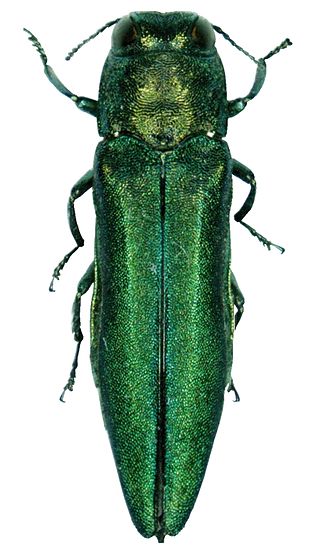
The emerald ash borer, also known by the acronym EAB, is a green buprestid or jewel beetle native to north-eastern Asia that feeds on ash species. Females lay eggs in bark crevices on ash trees, and larvae feed underneath the bark of ash trees to emerge as adults in one to two years. In its native range, it is typically found at low densities and does not cause significant damage to trees native to the area. Outside its native range, it is an invasive species and is highly destructive to ash trees native to Europe and North America. Before it was found in North America, very little was known about emerald ash borer in its native range; this has resulted in much of the research on its biology being focused in North America. Local governments in North America are attempting to control it by monitoring its spread, diversifying tree species, and through the use of insecticides and biological control.
Occidentalia is a monotypic moth genus of the family Crambidae described by Harrison Gray Dyar Jr. and Carl Heinrich in 1927. It contains only one species, Occidentalia comptulatalis, described by George Duryea Hulst in 1886. It is found in North America, where it has been recorded from Alberta, Indiana, Maine, Manitoba, Minnesota, New York, Ontario, Quebec and Saskatchewan.
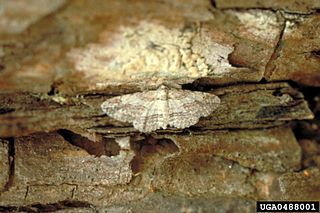
Iridopsis pergracilis, the cypress looper moth, is a moth of the family Geometridae. The species was first described by George Duryea Hulst in 1900. It is found in the US from Maryland to Florida.

Monoptilota is a genus of snout moths. It was described by George Duryea Hulst in 1900. It contains only one species, the lima-bean vine borer moth, which is found in the central and south-eastern parts of the United States.
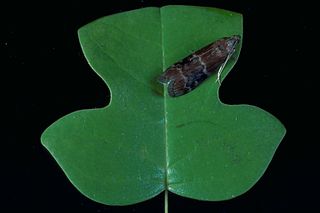
Euzophera ostricolorella, the root collar borer moth or tuliptree borer, is a species of moth of the family Pyralidae. It was described by George Duryea Hulst in 1890. The species is found in the United States from Arkansas and Louisiana to northern Florida, north to Michigan and New York.

Apomyelois bistriatella is a species of snout moth in the genus Apomyelois. It was described by George Duryea Hulst in 1887. It is known from California, the eastern United States, northern Europe and Russia.
Euzophera osseatella, the eggplant borer, is a species of snout moth in the genus Euzophera. It was described by Georg Friedrich Treitschke in 1832. It is found in Great Britain, France, Spain, Portugal, Italy, Sicily, Sardinia, Corsica, Croatia, Greece, Cyprus, Syria, Israel and North Africa.
Cactobrosis longipennella is a species of snout moth in the genus Cactobrosis. It was described by George Hampson in 1901 and is found in Mexico.
Melitara junctolineella is a species of snout moth in the genus Melitara. It was described by George Duryea Hulst in 1900. It is found in southern Texas and Mexico. The species has been introduced in Australia as a biological control agent of Opuntia stricta.
Rumatha glaucatella is a species of snout moth in the genus Rumatha. It was described by George Duryea Hulst in 1888. It is found in North America, including southern Texas and Florida.

Elophila gyralis, the waterlily borer moth, is a moth in the family Crambidae. It was described by George Duryea Hulst in 1886. It is found in eastern North America, where it has been recorded from Alabama, Florida, Georgia, Illinois, Indiana, Iowa, Louisiana, Maine, Maryland, Massachusetts, Michigan, Minnesota, Mississippi, New Brunswick, New Hampshire, New Jersey, New York, North Carolina, Nova Scotia, Ohio, Oklahoma, Ontario, Pennsylvania, Quebec, South Carolina, Tennessee, Texas and Wisconsin.
Anania labeculalis is a moth in the family Crambidae. It was described by George Duryea Hulst in 1886. It is found in North America, where it has been recorded from Arizona to western Texas.
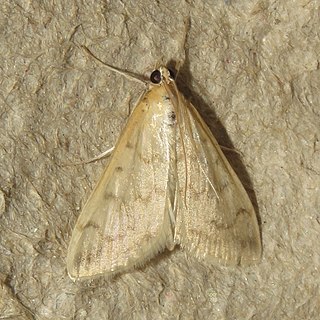
Hahncappsia pergilvalis is a moth in the family Crambidae. It was described by George Duryea Hulst in 1886. It is found in North America, where it has been recorded from Ontario and the north-eastern and south-western United States. It is also present in Mexico, where it has been recorded from the Federal District, Puebla and Jalisco.
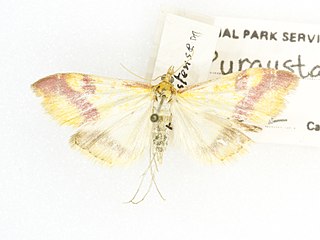
Pyrausta scurralis is a moth in the family Crambidae. It was first observed and described by George Duryea Hulst in 1886. It is found in North America, where it has been recorded/reported in the Canadian provinces of Ontario, Manitoba and Saskatchewan to the US states, California, Arizona, and New Mexico and in Mexico.
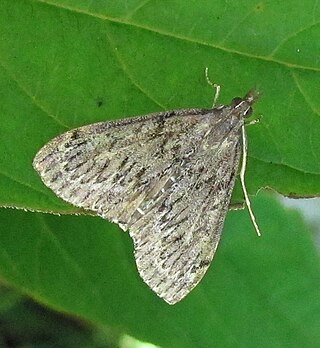
Saucrobotys fumoferalis, the dusky saucrobotys moth, is a moth in the family Crambidae. It was described by George Duryea Hulst in 1886. It is found in North America, where it has been recorded from Nova Scotia west to British Columbia, north to Yukon, and south to Pennsylvania, Illinois and California. The habitat consists of boreal forests, mixed forests and woodlots.
Choristostigma roseopennalis is a moth in the family Crambidae. It was described by George Duryea Hulst in 1886. It is found in Mexico and the United States, where it has been recorded from Arizona, Georgia, Indiana, Maryland, North Carolina, Ohio, Tennessee and Texas.
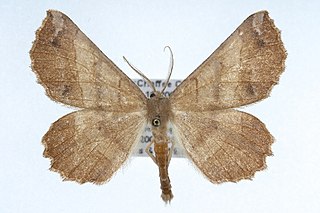
Euchlaena johnsonaria, or Johnson's euchlaena moth, is a moth of the family Geometridae. The species was first described by Asa Fitch in 1870. It is found in North America, where it has been recorded from southern coastal British Columbia east to Nova Scotia, south to New Jersey, Missouri and Oregon. The habitat consists of deciduous wooded areas.
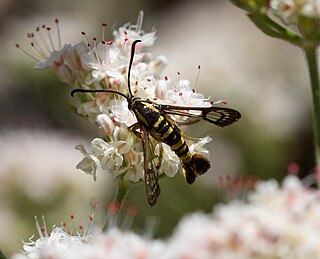
Synanthedon resplendens, also known as the sycamore borer moth, is species of a clearwing moth native to western North America. Larva of this moth live under the bark of sycamore, ceanothus, coast live oak, and, on rare occasions, avocado trees. Sycamore hosts include California sycamore, Arizona sycamore, and American sycamore trees. Coast live oak is a confirmed host, but this moth likely uses many or most other western oaks as well.












